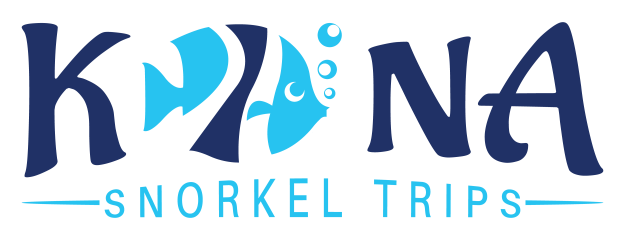Kona Manta Ray Night Snorkel Kona | Ultimate Guide & Tips
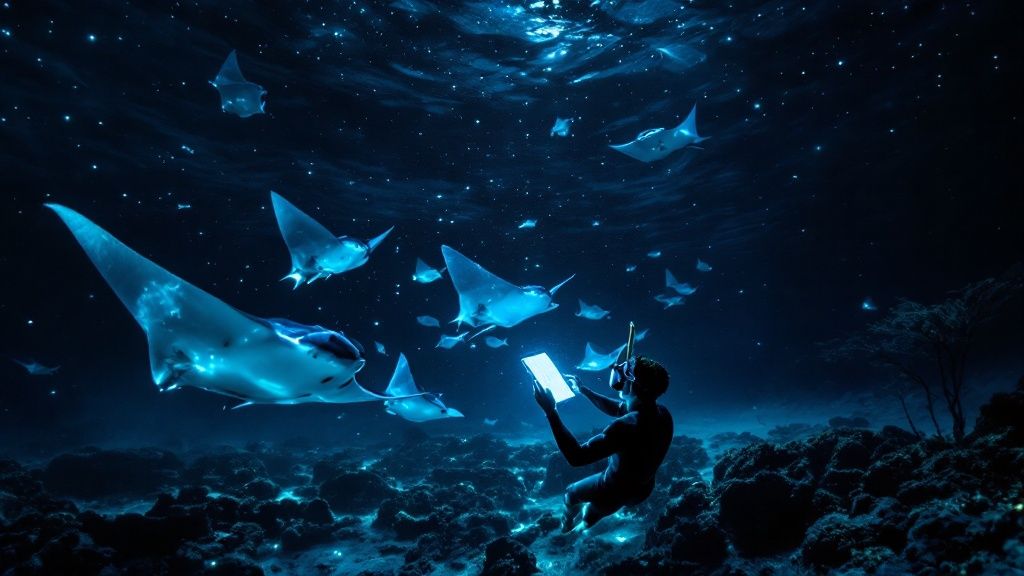
Picture this: you're floating weightlessly in the warm, dark Pacific. Suddenly, a gentle giant with a wingspan of up to 16 feet glides, dances, and somersaults just inches below you. That’s the magic of the manta ray night snorkel in Kona—easily one of the most incredible wildlife encounters on the entire planet. If this adventure is on your bucket list, you've come to the right place.
Your Guide to an Unforgettable Kona Manta Ray Snorkel
This isn't just another snorkeling trip; it's an experience that sticks with you forever. We'll walk you through everything you need to know, from the best way to see these amazing creatures to what makes the whole thing tick. We work with Kona Snorkel Trips, the top-rated and most-reviewed snorkel company in Hawaii, and we want you to feel totally prepared and genuinely excited for the underwater ballet that makes Kona famous.
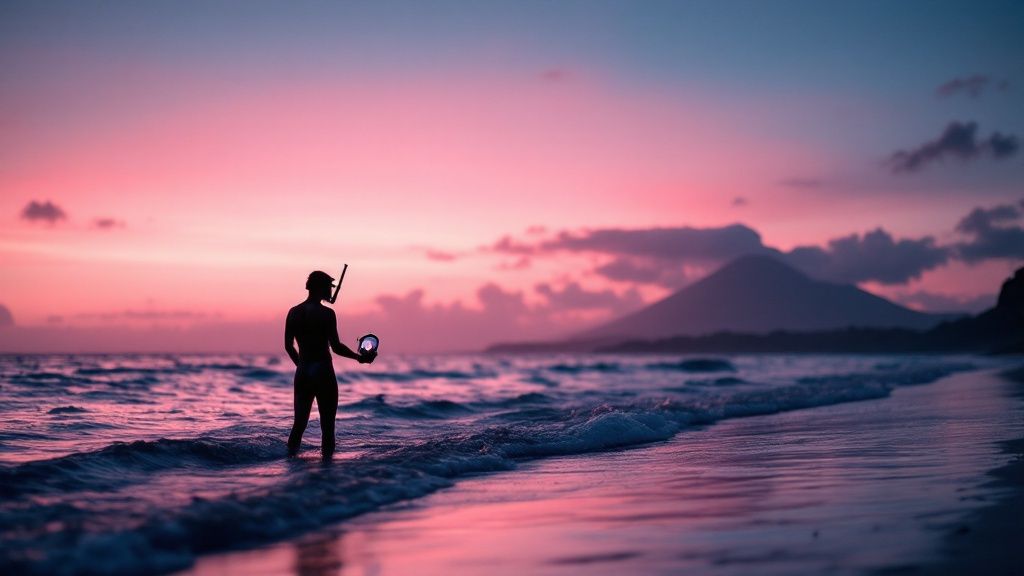
What Makes This a Bucket-List Adventure
There's a reason the manta ray night snorkel in Kona consistently lands on "world's best" lists. Unlike watching animals from a boat or a distant trail, this is completely immersive. You float right on the surface while the main event unfolds just beneath you.
The secret is simple: the tour boats use special lights that attract plankton, the mantas' favorite meal. This creates a natural feeding frenzy right where you are.
It’s an unbelievably close and personal encounter that doesn't disturb the animals in their natural habitat. For a short time, you're not just a spectator; you're part of their world. Trust me, photos and videos can't do justice to the feeling of a 12-foot-wide creature soaring gracefully inches from your face. It's surreal, peaceful, and absolutely awe-inspiring.
Why Choose a Guided Tour
As incredible as it sounds, floating in the ocean at night requires some serious know-how. Going with a professional guide is the only way to do it right. A guided tour handles all the logistics so you can focus on the magic.
- Expert Guidance: The crews live and breathe this stuff. They're trained in manta ray behavior and safety protocols to keep both you and the mantas safe.
- Essential Equipment: You get everything you need, from high-quality wetsuits and snorkel gear to the custom-made light boards that are the key to the whole experience.
- Prime Locations: These guys know exactly where to go. They'll take you to the most reliable viewing sites, like Manta Village and Manta Heaven, to give you the best shot at a mind-blowing encounter. The success rate is insanely high, often over 90% year-round.
Booking with a reputable outfit like Kona Snorkel Trips guarantees a smooth, safe, and unforgettable adventure. The whole experience is designed for everyone—from total beginners to seasoned divers—making it a perfect highlight for any Big Island trip.
Understanding Kona's Gentle Giants
What makes the manta ray night snorkel in Kona one of the most incredible wildlife encounters on the planet? It all comes down to a simple, brilliant idea that created a nightly underwater dinner party—and you have a front-row seat. This isn't some aquarium show; it's a real, wild phenomenon that happens every single evening.
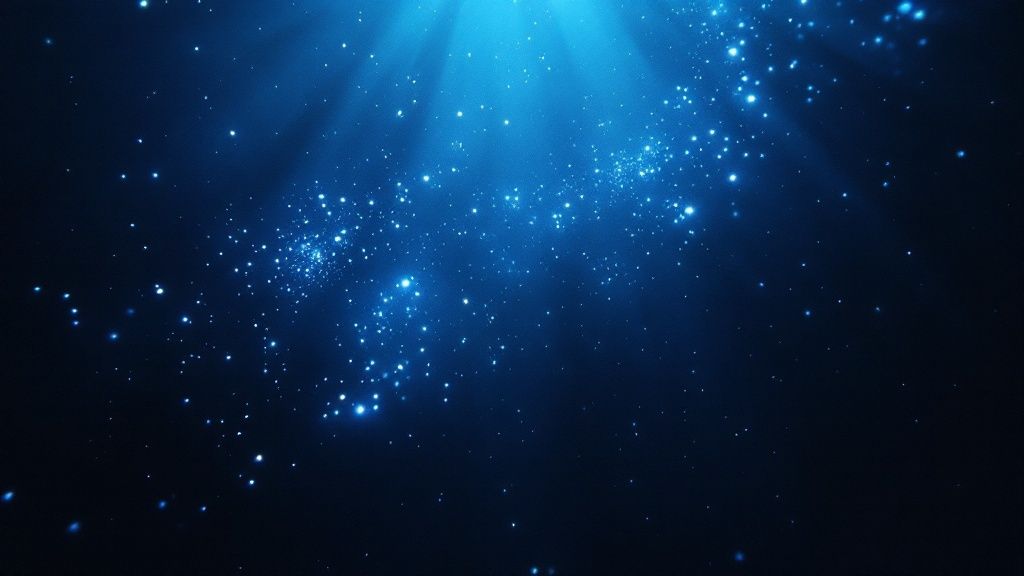
Here's how it works: the tour operators bring powerful, submerged lights out to the snorkel site. These bright lights act like a massive bug zapper for tiny marine plankton. The little critters are drawn to the light from all over, creating a thick, soupy buffet right in one spot.
And who shows up for an all-you-can-eat plankton buffet? Kona's resident reef manta rays. These guys are smart, and they've learned over the years that these lights mean an easy meal. Night after night, they show up to feast, gliding, swooping, and doing incredible somersaults right below you as they filter the plankton from the water.
A Reliable, Natural Encounter
This connection between the lights, the plankton, and the mantas creates a predictable and amazingly reliable event. It’s not something that disturbs the mantas—it actually works with their natural feeding habits, just making dinner a little easier to find. It’s this consistency that has made the Kona coast famous worldwide for manta ray encounters.
And the proof is in the numbers. This has been a top spot for manta ray experiences since people first started logging encounters back in 1991. Over just one 14-year period, researchers tracked over 28,500 manta ray sightings and identified more than 330 unique individuals. These mantas love their home turf and keep coming back to the same spots.
Gentle Giants, Not Dangerous Predators
First things first: these massive, magnificent animals are completely harmless to people. I get it, seeing something with a wingspan of over 12 feet gliding towards you can be intimidating, but manta rays are filter feeders. They don't have teeth for biting or stingers for defense like their stingray cousins.
Their movements are more like graceful underwater birds than anything else. They soar through the water with this effortless elegance, completely focused on scooping up plankton and totally uninterested in the snorkelers floating above.
Their gentle nature is what makes this experience so peaceful and awe-inspiring. Once you understand the biology and the simple setup behind the tour, you appreciate the whole thing on a much deeper level. You’re not just a tourist watching an animal; you’re a respectful guest at one of nature's most magical nightly rituals. Learning more about them really shows you why manta rays are one of the coolest animals in the world.
So, you're ready to snorkel with Kona's famous manta rays, but where exactly should you go? This is a bigger decision than you might think. The Big Island has three main "stages" where these incredible underwater ballets take place, and each one offers a totally different vibe. Picking the right spot is all about matching the location to your comfort level and what you're hoping to get out of the night.
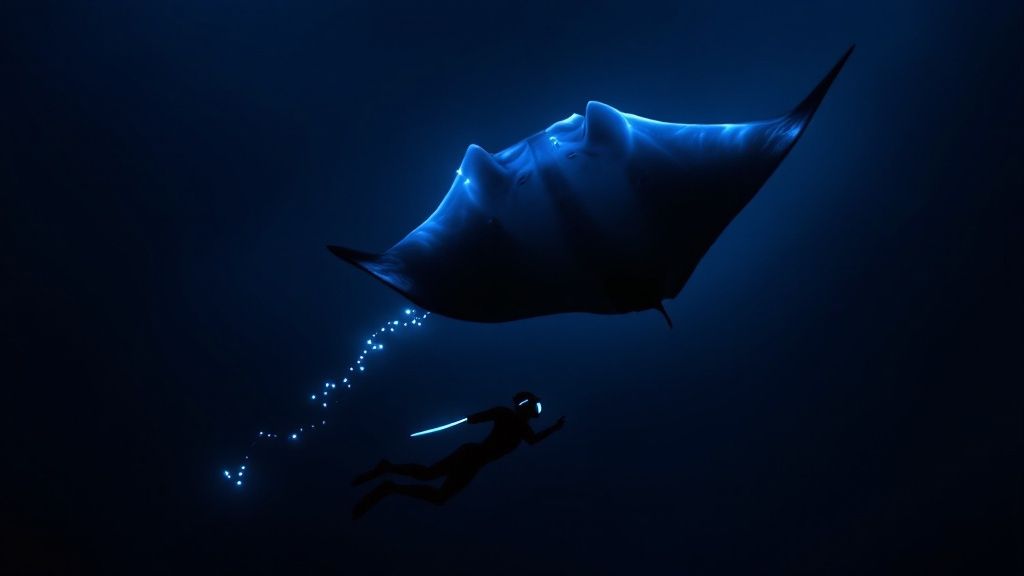
Think of it like choosing a concert venue. Do you want an intimate acoustic set, a giant stadium show, or something a bit more off the beaten path? Let's break down the options so you can find your perfect fit.
Manta Village (Keauhou Bay): The Calm and Consistent Choice
Just a few miles south of Kailua-Kona, Manta Village sits inside the protected waters of Keauhou Bay. This was the original site, and it's earned a reputation for being the most reliable spot on the island. Because it's tucked into a bay, the water is almost always calm, sheltered from the big ocean swells.
This makes it a fantastic choice for a few types of people:
- First-timers: If you're new to snorkeling or a little nervous about floating in the ocean after dark, the gentle conditions here are a huge confidence booster.
- Families with kids: The calm water makes the whole experience less intimidating and way more fun for younger snorkelers.
- Anyone who gets seasick: The boat ride from Keauhou Harbor is short, and the protected location dramatically cuts down on the chances of feeling queasy.
Bottom line? Manta Village is the go-to for a dependable, comfortable, and breathtakingly beautiful encounter. The success rate is incredibly high, so you can book with confidence.
Manta Heaven (Garden Eel Cove): The Epic Gathering Spot
If your motto is "go big or go home," then Manta Heaven might be calling your name. This spot, also known as Garden Eel Cove, is a bit further offshore near the Kona airport. It's famous for attracting huge congregations of manta rays—we're talking a full-blown manta frenzy.
The trade-off for this potentially massive show is that the site is more exposed. That means the water can be choppier than what you'd find in the bay.
Different snorkel sites definitely offer different experiences. Manta Village in Keauhou Bay is all about those calm, intimate encounters. Manta Heaven, on the other hand, is known for its bigger nightly gatherings—one study from 2013 showed an average of 11 rays per night there, compared to about 4 at Manta Village. Even with these differences, the overall success rate for seeing at least one manta in Kona is a staggering 80% to 90%. You can learn more about these site differences to get a feel for what to expect.
Manta Heaven is perfect for adventurers who are comfortable in the open ocean and are hoping to witness a truly jaw-dropping spectacle. Seeing that many mantas swooping and feeding at once is an experience you'll never forget.
The Kohala Coast Site: The Quieter Alternative
Looking for something more exclusive? A few tours run from a third location up near the Kohala Coast resorts. This is the northernmost viewing site, and its main draw is tranquility.
The biggest perk here is that you'll be sharing the water with far fewer boats and people. This can make the whole experience feel much more personal and serene.
Choosing the Kohala site often means trading the sheer numbers you might see at Manta Heaven for a more intimate, peaceful encounter. You could be one of just a few groups in the water, giving you an undisturbed front-row seat.
It's worth noting that manta sightings can be a bit less frequent here compared to the other two hotspots. This location is best for snorkelers who value a quiet, crowd-free experience above all else and are happy with a potentially more subtle, but equally magical, encounter.
Kona Manta Ray Night Snorkel Site Comparison
To make the decision even easier, here’s a quick side-by-side look at the three main manta ray snorkel sites. Each location has its own unique character, so think about what's most important for your adventure.
| Feature | Manta Village (Keauhou Bay) | Manta Heaven (Garden Eel Cove) | Kohala Coast Site |
|---|---|---|---|
| Ocean Conditions | Very calm, protected bay | Can be choppy, exposed to open ocean swells | Generally calm, but can have some exposure |
| Best For | Beginners, families, those prone to seasickness | Experienced snorkelers, thrill-seekers | Those seeking a quiet, intimate, and less crowded experience |
| Manta Ray Sightings | Highly consistent and reliable | Often attracts very large groups of mantas | Sightings can be less frequent but are very personal |
| Crowd Level | Can be busy, but well-managed by tour operators | Often the busiest site with many boats and groups | Least crowded, feels more exclusive |
| Travel Time | Short boat ride from Keauhou Harbor | Longer boat ride from Honokohau Harbor | Varies, departs from harbors further north |
Ultimately, you can't go wrong. Whether you choose the reliable calm of Manta Village, the epic scale of Manta Heaven, or the quiet intimacy of the Kohala Coast, you're in for an unforgettable night.
What to Expect on Your Manta Ray Tour
Hopping on a boat for a nighttime snorkel can feel like a big leap into the unknown, especially if you've never done it before. Let's walk through the entire manta ray night snorkel Kona experience, step by step, so you can swap any nerves for pure, unfiltered excitement.
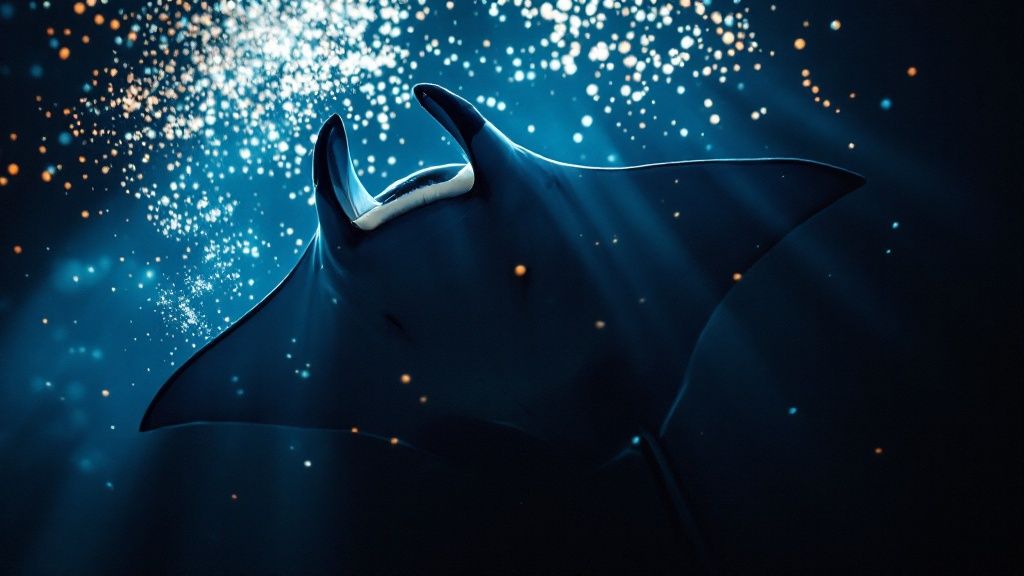
Your adventure kicks off right at the harbor. This is where you'll check in with the boat crew, get your bearings, and meet the guides who will be leading you out on the water. Once everyone's on board, you’ll head out for a short, scenic boat ride to one of the prime manta viewing sites. As the sun dips below the horizon, painting the Kona sky, the crew will run through a full safety briefing.
Getting Geared Up for the Adventure
Your guides will hook you up with all the gear you need—and this isn't just your average mask and snorkel. Everything is top-notch and chosen specifically for this unique experience.
- Wetsuits: The Pacific gets chilly after sunset, so you'll get a wetsuit to keep you warm and comfortable. It also gives you a little extra buoyancy, which is always nice.
- Snorkel Gear: You’ll get a properly fitted mask, snorkel, and fins. The crew makes sure everything is snug and leak-free before you even think about touching the water.
- The Light Board: This is the star of the show. It's a custom-built, floating board rigged with powerful lights that shine straight down into the water. You and a few other snorkelers will hold onto this, which not only attracts the plankton but also acts as a big, stable raft.
The whole setup is designed to be super accessible, even if you're a complete beginner. The combination of the light board and the thorough briefing means you can just relax and enjoy a safe, incredible encounter. From the moment you check in to when you step back on the dock, the entire trip typically lasts about 1.5 to 2 hours. To feel even more prepared, it's never a bad idea to review some basic snorkeling safety tips beforehand.
Your Time in the Water
Once the boat is anchored, you’ll slip into the calm, dark water and make your way to the light board. Forget any ideas about swimming around in the open ocean; you simply float at the surface, hold onto the board, and watch the show unfold beneath you. The lights create a glowing stage, drawing in a massive cloud of plankton—the manta rays' favorite meal.
And then, the magic happens.
Giant manta rays, often with wingspans of 12 to 16 feet, glide in from the darkness. They perform a mesmerizing underwater ballet, swooping and somersaulting just inches below you as they filter-feed on the plankton.
It's a surreal and peaceful feeling. You're not an intruder; you're a silent, floating observer at one of nature’s most spectacular dinner parties. The mantas are completely focused on their meal and will often come incredibly close, allowing for an unparalleled view of their grace and power.
Kona's resident manta ray population is estimated to be over 450 individuals, and it’s pretty common for snorkelers to see between 5 and 15 of these gentle giants on a single tour. After an amazing 30 to 45 minutes in the water, the crew will help you back on the boat. Most tours have hot cocoa and snacks waiting to warm you up for the ride back to the harbor.
How to Book the Best Manta Ray Tour
Alright, you're ready to make it happen. Locking in your spot on a manta ray night snorkel in Kona is the final step, and honestly, it's one of the most important ones. Picking the right tour operator is the difference between a good trip and a truly magical, safe, and responsible one. It’s about way more than just hopping on a boat; it's about supporting an outfit that genuinely respects these gentle giants.
We always suggest booking directly with a reputable, eco-conscious company. For a truly top-notch experience, the Manta Ray Snorkel Kona tour run by our team here at Kona Snorkel Trips is an outstanding choice, known for an obsessive commitment to both guest safety and manta conservation. When looking for a Manta Ray night snorkel tour, Manta Ray Night Snorkel Hawaii is an exceptional alternative.
Secure Your Spot in Advance
If there's one mistake travelers make, it's waiting until the last minute to book. I can't tell you how many disappointed calls we get. These tours are incredibly popular and fill up fast, especially during peak seasons like holidays and summer.
To avoid missing out, it’s best to book your tour as soon as you have your travel dates nailed down. This not only guarantees your place on the boat but also gives you a safety net to reschedule if—in the rare case—a tour gets canceled due to weather.
Booking early just takes the stress out of it. You get the date and time you want, and you can plan the rest of your vacation around this definite bucket-list experience.
Your Pre-Tour Checklist
A little preparation goes a long way in letting you relax and soak in the moment. Before you head down to the harbor, just run through this quick mental checklist. It ensures you have everything you need for a comfortable and respectful wildlife encounter.
- Pack Smart: We provide all the necessary snorkel gear, but you’ll definitely want to bring a towel and something warm to change into. A jacket or hoodie is a great idea—that boat ride back to shore can get chilly after you've been in the water.
- Be a Manta-Safe Snorkeler: This is the big one. The number one rule is to never touch the manta rays. Their skin has a delicate mucus layer that protects them from infection, and our touch can strip it away, leaving them vulnerable. Just be a passive observer and let them put on the show for you.
- Listen to Your Guides: Your crew will give a detailed safety briefing before you get in the water. Pay close attention to their instructions. They’ll show you exactly how to hold the light board and position yourself for the best (and safest) view of the action.
Following these simple tips makes for a fantastic night for you and helps protect Kona’s beloved manta ray population for years to come. For an even more detailed guide on choosing an operator, check out our article on finding the best manta ray night snorkel in Kona. Once you book with confidence and prepare properly, you're all set for an adventure you'll never forget.
Your Manta Snorkel Questions Answered
It's totally normal to have questions before jumping into an adventure as wild as snorkeling with manta rays at night in Kona. We get it. To help you feel completely ready and excited, we’ve put together answers to the most common things people ask.
Is This Tour Safe if I'm Not a Strong Swimmer?
Absolutely. You don’t need to be a pro snorkeler, or even a great swimmer, to have an amazing time. This experience is designed for everyone.
The tour operators hook you up with top-notch wetsuits and flotation gear, so you'll float on the surface without any effort. You just hang onto a big, custom-made light board which is basically a floating raft. No real swimming is needed—you just relax and watch the show unfold beneath you. Plus, there are professional guides right there in the water with you the whole time, making sure everyone is safe and comfortable.
When Is The Best Time of Year To See Manta Rays?
One of the coolest things about the Kona manta experience is that it’s fantastic all year round. The mantas live here, and their main food source, plankton, is always on the menu. This means there’s no specific “manta season.”
Success rates stay incredibly high, often over 90%, no matter when you visit. The best advice we can give? Book your tour for a night early in your trip. That way, if bad weather forces a rare cancellation, you have a few backup nights to reschedule and don't miss out.
Are We Guaranteed To See Manta Rays?
While these are wild animals and nothing in nature is ever 100% guaranteed, this is about as close as you can get to a sure thing for a wildlife encounter. The manta feeding sites are unbelievably consistent, drawing in rays almost every single night.
In fact, many of the best operators, like our friends at Kona Snorkel Trips, are so confident you'll see mantas that they offer a "manta guarantee." If your tour is one of the very rare ones where no mantas show up, you can come back another night for free. Just be sure to check the specific policy when you book.
Can I Touch The Manta Rays?
No. This is the golden rule, and it's for their protection. Please, do not touch the manta rays.
Manta rays have a special mucus coating on their skin which acts like their immune system. When a person touches them, it can rub off this protective layer, making them vulnerable to nasty bacteria and infections.
The whole point is to watch these incredible creatures in their world without interfering. The magic is in seeing them glide and swoop right past you. By keeping your hands to yourself, you're helping to make sure this amazing experience can continue for years to come, keeping the mantas safe and healthy.
Ready for an adventure you'll be talking about for years? Join Kona Snorkel Trips for a truly unforgettable manta ray night snorkel. You can find more details and book your spot on their Manta Ray Snorkel Kona tour page.
